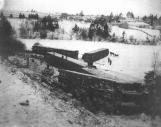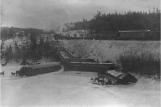1
Canadian Pacific Railway train number 25 left Halifax at 7:00 a.m. on January 26th, 1897 bound for Montreal. The train was typical of most of the trains on that run it included an engine, baggage car, second class coach, first class coach, a diner and a sleeper car, plus 25 passengers. However, the train also included an unusual shipment of about 900,000 newly-minted Canadian one cent coins, half of the total number of one cent coins minted that year. The coins dated 1896 were stowed away in the Mail Express car behind the engine. The train arrived in Sackville at 12:00 p.m. running late but otherwise the trip from Halifax had been uneventful and the train soon left Sackville for its next stop Dorchester. Two miles east of Dorchester trains descend down a steep grade from 234 feet above sea level down to 27 feet. At one mile from Dorchester the train was continuing down the steep grade passing through two sharp curves which formed an "S" curve around Palmer's Pond. Suddenly without warning while passing through the first curve the mail car jumped the rails, which then derailed the cars behind it. These cars then ran along the wood ties for another 150 feet before plunging down a 25 foot embankment and onto the frozen pond. The cars traveled a few more feet on their sides before finally coming to rest on the frozen pond. One woman went partially out through a window and was pinned under the car, she died on the scene. In the baggage car postal clerk Arthur C. Edgecombe was pinned under an iron rack used to hold mail bags. Extracting him was difficult because the iron rack was preventing the collapse of the side of the car. By the time he was removed he also had died. The other passengers had been tossed violently around the passenger cars, they quickly scrambled out of the cars and headed for the safety of the embankment. It is fortunate that the accident happened in winter or many more passengers would have drowned trying to escape the cars. The engine of the train which had not been derailed took off immediately to summon help. News spread quickly and people rushed to the scene leaving many half eaten bowls of soup at the Hotel Windsor. An auxiliary train with Doctors and track crews was dispatched from Moncton and arrived 90 minutes later. The injured were taken to the Hotel Windsor. The mail car had ended up upside down on the frozen ice and some 50 cases of pennies were now broken with their contents spread out on the ice. In some places the pennies were in piles more than three feet thick. Indeed many a curious bystander was able to pick up a shiny new souvenir of the accident, although ultimately most of the pennies were recovered from the wreck. Questions were immediately raised as to what had caused the wreck. Speed was considered but the train was only traveling 35 miles per hour. Another question was what role the -35 C temperature played in the accident. A definitive cause has never been determined but many people believe that the placement of the pennies caused the derailment. The pennies had been stored at the back of the mail car in 80 boxes which together weighed a total of 6.3 tons. This weight concentrated at the back of the car may have caused the front of the car to bounce up and down. As the car went around the curve this bouncing may have thrown the car off the track.2
Penny Wreck26 January 1897
Palmer's Pond, New Brunswick, Canada
 Credits:
Credits:New Brunswick Railway Museum
3
Penny Wreck26 January 1987
Palmer's Pond, New Brunswick, Canada
 Credits:
Credits:New Brunswick Railway Museum